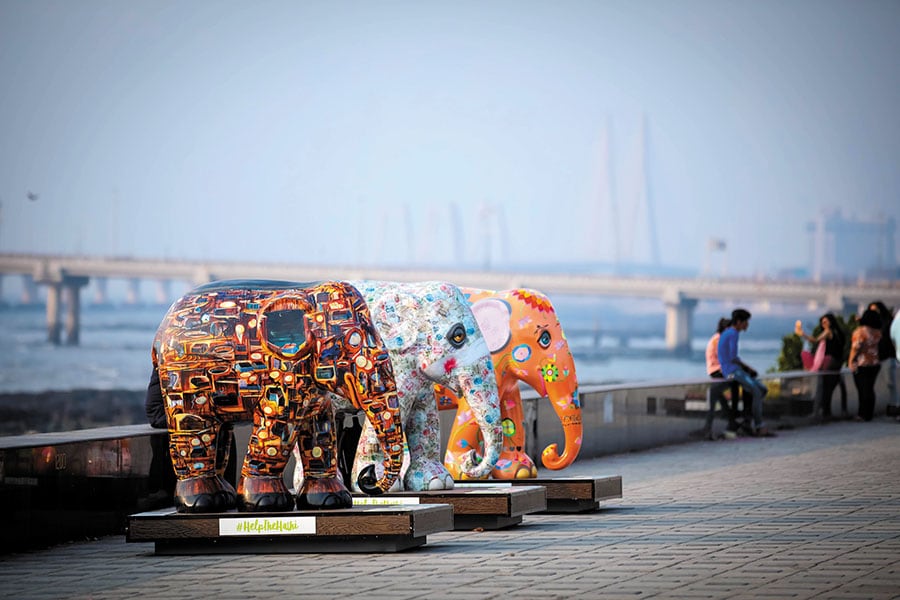
In India, there is a lot of tolerance, says Ruth Ganesh
The trustee of Elephant Family, talks about saving an icon—the Asian elephant
 Some of the sculptures that were installed on the Worli Sea Face in Mumbai
Some of the sculptures that were installed on the Worli Sea Face in Mumbai
Image: Umed Jadeja
The Elephant Parade, with a 24-city run around the world, stopped in Mumbai in March to raise funds for conservation of wild elephant corridors and habitat in the country. Organised by Elephant Family, a UK-based non-government organisation that raises funds for the conservation of the Asian elephant, the Elephant Parade India has engaged leading Indian artists, fashion designers, design institutes, tribal painters and celebrities to create 101 unique sculptures. These were auctioned to raise money for conserving 101 elephant corridors in the country. As of March 22, more than half of the sculptures had been sold, earning the project ₹4.2 crore (including donations).
Ruth Ganesh, trustee of Elephant Family, spoke to Forbes India about the organisation’s work, and how India has the capability of coming up with unique solutions.
Q. What does the Elephant Family’s work in India include?
We work with different organisations in India, such as the Nature Conservation Society in the south, and the Wildlife Trust of India (WTI). We are working with five partners in India, but the WTI is our dominant partner. This is because there are a lot of projects that are tight in their scope, in what they do; so you need that, and you also need the big-picture vision. WTI are the ones that have the big-picture vision, and they could come with the answer to the question, ‘If I have 2 million pounds, what would we do?’ Vivek Menon, the founder of WTI, is also the head of the Asian Elephant Specialist Group, which brings together all the scientists, conservationists and specialists in Asia.
We want to support individual projects, the mud-on-boots on-the-ground people, but also something that has a macro-approach to the whole problem. And that is very much the work of the [elephant] corridors.
Q. Are you more into raising and channeling funds, or getting more involved in local projects?
I am a big cheerleader of people who work on the ground. We are very conscious of the fact that we are from the West, and it is all very well for the West—who have wiped out all their bears, wild horses and wolves—to sit there and say, ‘Please can we save your elephants’. When we started, we tried to be completely invisible, and just send money; there was no branding at all. But it’s difficult to keep money coming in when you can’t see your donors, and the connections. So we now work in visible partnerships. Over the years, our role has developed from being a funder to also building public relations, where we manage to engage huge constituencies within countries and cities like the US, New York and London. And I am fascinated by how this model has worked in countries that don’t have a single elephant.
The next three weeks [over which the Elephant Parade sculptures will be auctioned] in India will show us whether we can be a useful influencer in a positive way, a useful ally in turning the conversation around conservation and corridors.
In other parts of Asia, there is dubious wildlife trade with live elephants. So we sometimes fund and power investigations into what is happening on the ground, and intervene. For instance, the IUCN [International Union for Conservation of Nature] ran a campaign for tightening loopholes in laws in Thailand, where wild elephants were being caught, and were being passed off as captive-born for eco-tourism. We campaigned for tightening the laws that were allowing all sort of abusive practices.
So we do active work as well, but our primary task is to cheerlead and empower those who are doing the work on the ground, whether in India or Indonesia.

Image: Elephant Family
Q. What are the threats to habitat conservation in India?
There is agriculture, as well as infrastructure—railroads are becoming double gauge, new roads are being built, electricity poles are being put up in remote villages. These are completely reasonable and positive things to do, but it’s not entirely positive if the conservation community is not engaged, and if there is not enough planning.
There was a breakthrough a couple of weeks ago in India when it was mandated by the Ministry of Environment, Forest and Climate Change that infrastructure projects through sanctuaries and protected areas will have to inlcude a plan and budget for safe movement of wildlife. The next thing, of course, is to make sure that actually happens, but at least this is a step in the right direction. For the conservation community in India, that is a big thing.
There are many brilliant conservations in India. For instance, Sanjay Gubbi managed to navigate the system so that roads that passed through tiger reserves were closed at night; earlier, tigers were being lost to road kill. It was not about closing the road entirely. It is sometimes about making tweaks to what is already in place, rather than make new laws. That’s why India is so amazing. It has got a population similar to China’s, but India has 27,000 wild elephants, while China has 200. And it is because of this ability to co-exist.
We always smile at the stories that come in [from India]. There is a wonderful story from southern India about a wall that was built on a path through which a herd of elephants would pass every year. The animals would knock down the wall and go through. After a few years, the community accepted it. Now, they just put the wall back up without cementing it. So they allow it to be knocked down, and put it back again. That is the Indian mindset that the rest of the world should learn from. There is a lot of tolerance.
Q. What is the situation like in other Asian countries?
In Asia, people who live close to elephants generally have a deep understanding of the animals; they have a general reverence for them. They are the ones who lose their crops, and often members of their families, and yet there is a general sense that they are ones who have taken the elephants’ land, and that they are hungry.
Things are different when there is more of corporate influence. For instance, 14 elephants were poisoned intentionally in a palm oil plantation in Borneo a few years ago; the elephants had lost their migratory path and were passing through the plantation, damaging the crops. That does not happen in India.
In India, there is a deep concern among conservation communities about how to balance the incredible economic growth that is going on with ensuring that the elephants and tigers and rhinos still have a place in this world.
Q. What brought Elephant Parade to India?
We always wanted to do it India. There were a lot of naysayers, saying that you can’t do it, because you have to find a very specific set of people—you have to find your curator, and your politician. Poonam Mahajan [Member of Parliament and Elephant Parade Ambassador] had us living in her office; she has been our equivalent of lord Ganesh, and has removed the obstacles one by one. I can’t believe she got us the Gateway [for the inauguration], she got us the permissions to put the elephant sculptures on display everywhere. It took us quite a while to find the right circumstances and people.
Our curator, Farah Siddique, knows the art world here really well, and how to attract the right talent. One of our patrons, Vikram Goyal, got us people like Rohit Bal and Tarun Tahiliani. Each of the sculptures takes about three or four months to make. Each of the artists seems to have an amazing affinity with elephants, with stories.
We have 101 sculptures, and we have 101 elephant corridors. So we have twinned each of the sculptures with each of the corridors.
(This story appears in the 13 April, 2018 issue of Forbes India. To visit our Archives, click here.)
















